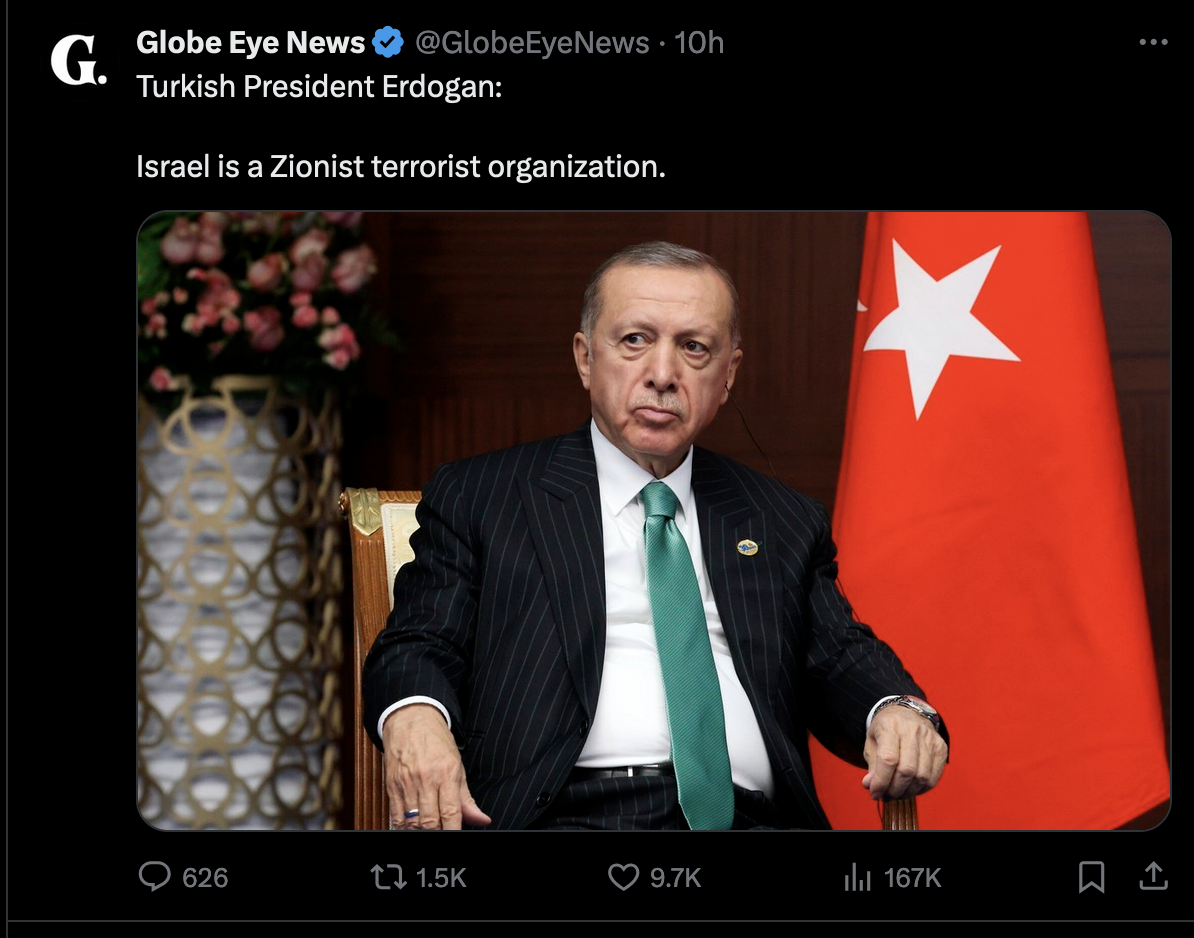

By Dr. Tim Orr
Caution: The following content may contain potentially disturbing images.
In light of the recent conflict between Israel and Hamas, there has been a sharp increase in antisemitic rhetoric across social media platforms. Scholars such as Günther Jikeli and Katharina Soemer have provided critical insights into how historical antisemitism, radical ideologies, and the nature of social media intertwine to spread this hate. The surge following Hamas’ attack on Israel on October 7, 2024, highlights the disturbing realities of Islamic antisemitism in online spaces and how it spills into the real world.
Tracing the Roots of Islamic Antisemitism
Islamic antisemitism has deep roots that stretch back centuries, though today’s version has evolved in complex ways. Historically, Jews under Islamic rule were often classified as “dhimmis,” a protected yet second-class status. While this arrangement allowed for relative coexistence, there were always underlying theological tensions, which have now been twisted into modern forms of antisemitism driven by both religious and political forces.
Islamic theology plays a significant role in shaping antisemitic attitudes, with verses from the Quran and Hadiths sometimes being used to frame Jews as adversaries. Extremist groups often misinterpret certain Quranic passages that reference Jewish communities' disobedience to justify hostility toward Jews today. What once might have been seen as historical grievances is now repurposed into a religious obligation, adding layers of theological validation to political conflicts, particularly the Israeli-Palestinian dispute.
With the founding of Israel in 1948 and subsequent conflicts, these theological prejudices have intensified, blending with political grievances. For Islamist groups like Hamas, the political struggle against Israel has taken on a religious dimension. Jews are no longer just opponents in a territorial conflict but are seen as historical and spiritual enemies. This religious framing of antisemitism has allowed it to thrive and spread in new ways, particularly on digital platforms.
Islamic Antisemitism in the Digital Age
Social media has amplified these ancient prejudices, making Islamic antisemitism more visible and dangerous. Platforms like X (formerly Twitter), TikTok, and Telegram have allowed antisemitic content to flourish, often mixing religious rhetoric with contemporary political complaints. The result is a narrative that dehumanizes Jews, glorifies violence against them, and justifies hate under the guise of religious duty.
One alarming example is the use of religious language to legitimize violence. Islamist groups like Hamas often refer to Quranic verses to frame their attacks on Israel as divinely sanctioned acts. In their eyes, fighting Jews is not only a political act but also a religious duty, a perspective that is quickly picked up and spread by their followers online. This framing resonates with Muslims globally, many of whom are influenced by this type of messaging, regardless of their proximity to the Israeli-Palestinian conflict.
The Spread of Islamic Antisemitism on Social Media
The speed at which antisemitic rhetoric spreads online is shocking. Social media platforms are designed to prioritize engagement—content that generates likes, shares, and comments. This means that the most provocative, emotionally charged, or controversial posts, often including antisemitic tropes, rise to the top. The more engagement these posts receive, the more the algorithms push them to broader audiences, amplifying the hate.
For instance, during and after the Hamas attack on Israel, social media exploded with antisemitic content. Posts glorifying violence against Jews and using religious justification to condone such violence spread rapidly. Hashtags like #FreePalestine and #DeathToIsrael trended across multiple platforms, often in posts that celebrated the deaths of Jewish civilians and encouraged further violence.
This convergence of religious rhetoric and political anger allows antisemitism to thrive in ways that are difficult to combat. It also demonstrates how easily social media algorithms can amplify hate speech, feeding it to users who may not have otherwise been exposed to such content. The result is a continuous feedback loop where the most extreme views get the most attention, fueling the spread of antisemitism.
Extremist Groups and Islamic Antisemitism
Islamic extremist groups like Hamas and Hezbollah play a significant role in fueling antisemitism online. These groups often blend political and religious messaging, framing the conflict with Israel as a divine battle. On social media, their narratives are easily accessible and often presented in ways that attract sympathizers who may not fully understand the complexity of the conflict.
Hamas, for example, frequently posts videos celebrating violence against Israeli civilians, using religious texts to justify their actions. These messages are framed as part of a larger religious struggle, with Jews being depicted not only as enemies of Israel but as enemies of Islam itself. This religious framing resonates deeply with some audiences and allows Hamas to position itself not just as a political movement but as the defender of Islam.




This is but a small snippet of what is going on online.
Theological Justifications for Violence: A Deeper Dive
At the core of Islamic antisemitism is the use of theological teachings. Extremists frequently cite some Quranic verses and Hadiths to justify antisemitism. A common example is Surah Al-Baqarah (2:61), which references the disobedience of the Children of Israel. Some Muslim scholars, mostly in the West, understand the verse within the context of specific events, but extremists now use it to claim that all Jews are inherently corrupt. This distortion of theology is dangerous and fuels much of the antisemitism we see today.
Similarly, some Hadiths are interpreted in ways that suggest an apocalyptic battle between Muslims and Jews. One particular Hadith, which mentions that Muslims will fight Jews before the end of time, has been widely used to justify violence against Jews, framing it as a divine mandate. This narrative is especially appealing to extremist groups, who see their political struggles as part of a larger religious war.
Cross-Ideological and Cross-Geographical Convergence
Jikeli and Soemer’s findings also reveal how online antisemitism transcends ideological and geographical boundaries, connecting far-left, far-right, and Islamist extremists in a shared hatred towards Jews. This convergence of antisemitic sentiment across different political spectrums is a significant departure from the traditional view that antisemitism was primarily the domain of the far-right. Today, antisemitic tropes and conspiracy theories are shared by users who otherwise hold vastly different political ideologies, united by a common hatred for Jews and the State of Israel.
One of the most prominent examples of this cross-ideological convergence is the "Holocaust inversion" narrative, which equates Israeli actions with Nazi atrocities. This narrative is popular among far-left activists, who view Israel as a colonial oppressor, and far-right extremists, who adhere to traditional antisemitic tropes of Jewish power and control. Islamist groups, such as Hamas, also capitalize on this narrative to justify their armed resistance against Israel. The widespread adoption of this trope reflects a broader trend in which antisemitism is reframed as anti-Zionism, blurring the lines between legitimate criticism of Israel and bigotry against Jews.
This convergence is facilitated by social media platforms, where users from different ideological backgrounds can interact and reinforce each other’s views. Jikeli and Soemer observe that platforms like X and Telegram have become hubs for antisemitic content, where far-right white supremacists and Islamist extremists find common ground in their hatred of Jews. This digital alliance has dangerous real-world implications, as it strengthens networks of hate and increases the potential for coordinated acts of violence.
Become a Paid Member
The Dangerous Consequences of Online Radicalization
The online dissemination of antisemitic content does not remain confined to the digital world—it has real-world consequences. Jikeli’s research underscores the fact that online antisemitism often translates into offline violence. The Tree of Life synagogue massacre in Pittsburgh, where the shooter cited antisemitic conspiracy theories as his motivation, serves as a chilling reminder of how online hate can lead to deadly outcomes.
The glorification of violence against Jews, particularly by Islamist groups like Hamas, is a key driver of this radicalization. On platforms like X and TikTok, users frequently post videos celebrating the deaths of Jews and calling for further violence. The normalization of such rhetoric desensitizes users to the real-world implications of their words, making violent action against Jews seem not only acceptable but necessary.
This radicalization is exacerbated by the echo chambers created by social media algorithms. Users who engage with antisemitic content are more likely to be exposed to further hate speech, reinforcing their existing biases and pushing them towards more extreme views. In this sense, social media platforms are not just passive conduits for antisemitism—they are active participants in its spread and escalation.
Strategies for Disruption
While the challenges posed by online antisemitism are daunting, Jikeli and Soemer believe that it is possible to disrupt the networks of hate that have taken root on social media. One key strategy is improving the detection and removal of antisemitic content. Although social media platforms have taken steps to address hate speech, their efforts have been inconsistent and often insufficient. Jikeli’s research lab at Indiana University employs teams of annotators with extensive knowledge of antisemitic tropes to manually identify hate speech, providing a model for how platforms might improve their detection methods.
Moreover, Jikeli and Soemer argue that education is crucial in combating antisemitism. Many users who spread antisemitic content do so out of ignorance rather than malice. By educating users about the historical roots of antisemitism and the dangers of spreading hate speech, it may be possible to reduce the prevalence of these narratives online.
Finally, Jikeli and Soemer emphasize the importance of international cooperation in addressing the global nature of online antisemitism. Since hate speech crosses national borders, efforts to combat it must be similarly transnational. Governments, tech companies, and civil society organizations must work together to create a safer and more respectful digital environment where hate speech cannot flourish unchecked.
Conclusion
Online Islamic antisemitism represents a dangerous convergence of historical prejudices, modern political grievances, and social media dynamics. As Jikeli and Soemer’s research shows, this form of hate speech is not only widespread but growing, fueled by algorithmic biases and cross-ideological alliances. The consequences of this rise in antisemitism are dire, with the potential to incite real-world violence and deepen societal divisions. Combating online antisemitism requires a multifaceted approach that includes better detection methods, public education, and international collaboration. Only by addressing the root causes of antisemitism, both online and offline, can we hope to disrupt the dangerous cycle of hate that threatens Jews around the world.
References
Jikeli, G. (2021). Detecting anti-Jewish messages on social media: Building an annotated corpus that can serve as a preliminary gold standard. Proceedings of the ICWSM Workshops. https://doi.org/10.36190/2021.14.
Jikeli, G. (2023, May 17). Proof that antisemitism is up on Twitter and other social media platforms. Indiana University Bloomington. https://isca.indiana.edu/news-events/archive/gunther-algemeiner.html
Jikeli, G., & Soemer, K. (2023, October 7). Online antisemitism before and after October 7 [Video]. YouTube. https://www.youtube.com/watch?v=YEnrnazhYq0
Tim Orr is a scholar, Evangelical minister, conference speaker, and interfaith consultant with over 30 years of experience in cross-cultural ministry. He holds six degrees, including a master’s in Islamic studies from the Islamic College in London. Tim taught Religious Studies for 15 years at Indiana University Columbus and is now a Congregations and Polarization Project research associate at the Center for the Study of Religion and American Culture at Indiana University Indianapolis. He has spoken at universities, including Oxford University, the University of Tehran, and mosques throughout the U.K. His research focuses on American Evangelicalism, Islamic antisemitism, and Islamic feminism, and he has published widely, including articles in Islamic peer-reviewed journals and three books.
 Dr. Tim Orr's BlogDr. Tim Orr
Dr. Tim Orr's BlogDr. Tim Orr
 Dr. Tim Orr's BlogDr. Tim Orr
Dr. Tim Orr's BlogDr. Tim Orr
Check out Dr. Orr's YouTube Channel
 YouTube
YouTube
